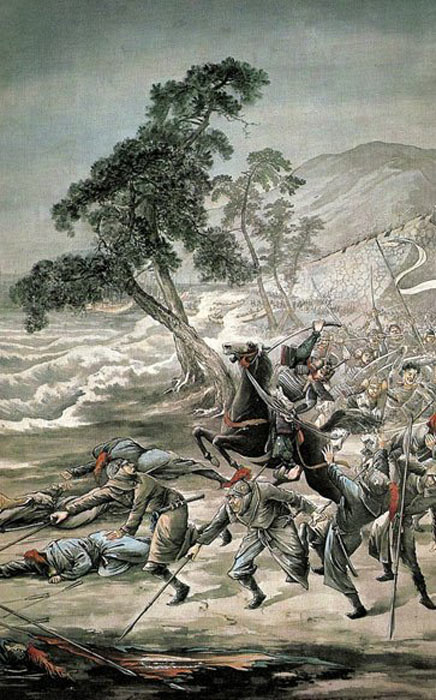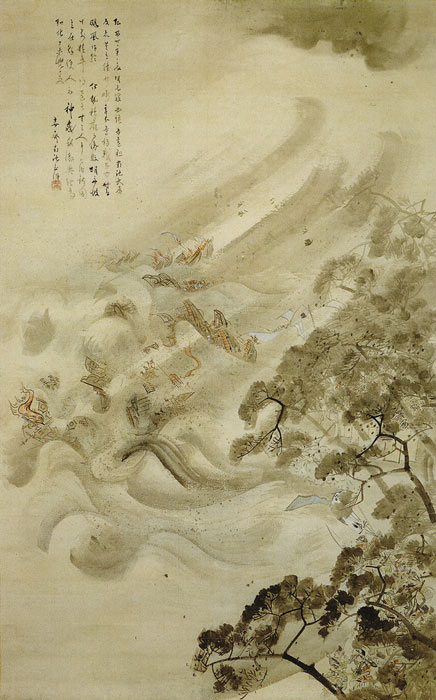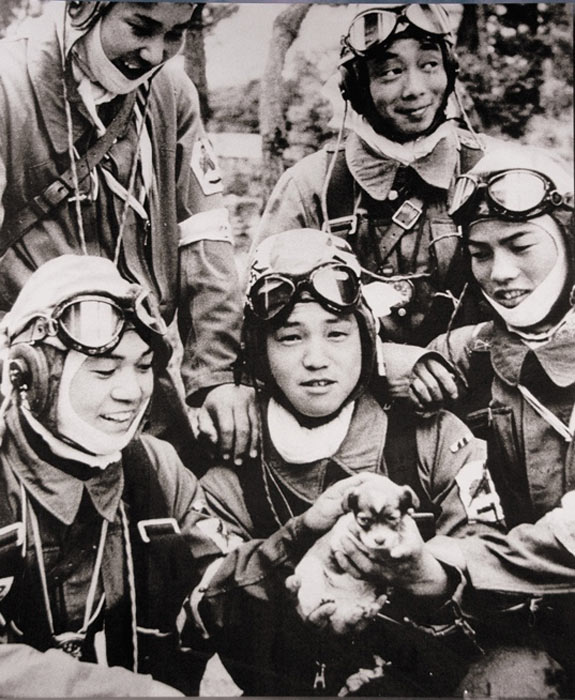
Kamikaze – The Divine Winds that Saved Japan
The Mongols attempted two major invasions of Japan during the 13th century, in 1274 and 1281 AD, led by Kublai Khan, grandson of Genghis Khan. On both occasions however, a massive typhoon (tropical cyclone) obliterated the Mongol fleet, forcing the attackers to abandon their plans and fortuitously saving Japan from foreign conquest. The Japanese believed the typhoons had been sent from the gods to protect them from their enemies and called them Kamikaze, meaning “divine wind.”
Following the conquest of China in 1230 and Korea in 1231, Kublai Khan become the first emperor of Mongolia and renamed it the Yuan Dynasty, meaning “first beginning.” Just 100 miles (160 km) away, Japan feared an invasion and they had every reason to. Between 1267 and 1274, Kublai Khan sent numerous messages to the Emperor of Japan demanding that he submit to the Mongols or face invasion. However, the messengers were blocked by Japan’s shogun, the real power behind the throne, and they never reached the Emperor.
- Kublai Khan: Mongol Warrior, Horseman, Hunter and Powerful Emperor
- The Genghis Khan Biography: Military Genius, Genocidal Maniac, Serial Abuser of Women
Kublai Khan became furious that he never received a reply from the Emperor, who he referred to as “ruler of a small country” and he vowed to invade Japan. The Mongols set to work on building an enormous fleet of warships and recruited thousands of warriors from China and Korea.

The Second Mongol Invasion of Japan. Mongols who survived the typhoon were slaughtered by Japanese samurai warriors at the water’s edge. (Yado Issho)
The Failed Mongol Invasions of Japan
In the Autumn of 1274, the Mongols launched their first invasion on Japan, which has become known as the Battle of Bun'ei. An estimated 500 to 900 vessels and 40,000 warriors, mostly ethnic Chinese and Koreans reached the shores of Hakata Bay where the two forces met. The Mongols devastated the Japanese forces who began to retreat.
However, fearing the Japanese were getting ready to return with reinforcements, the Mongols retreated to their ships. That night, the typhoon struck as the ships lay at anchor in Hakata Bay. By daybreak, only a few ships remained. The rest were destroyed, taking the lives of thousands of Mongols with them.
While the Japanese had a lucky escape in 1274, it was not over yet. The Mongols were now more determined than ever to conquer Japan. They worked hard to rebuilt their fleet and recruit greater numbers of warriors. Meanwhile, Japan built two-meter-high (6.56 ft) walls to protect themselves from future attacks.

Ink and watercolor depiction of the Mongol invasion and the destruction of the Mongol fleet in a typhoon, by Kikuchi Yoosai. (Public domain)
Seven years later, the Mongols returned with an enormous fleet of 4,400 ships and an estimated 70,000 to 140,000 soldiers to enact their second Mongol invasion of Japan. One set of forces set out from Korea, while another set sail from southern China, converging near Hakata Bay in August, 1281. Unable to find any suitable landing beaches due to the walls, the fleet stayed afloat for months and depleted their supplies as they searched for an area to land.
On August 15, the Mongols prepared to launch their assault on the much smaller Japanese forces defending the island. However, once again, a massive typhoon hit, wrecking the Mongol fleet and once again foiling the invasion attempt. Contemporary Japanese accounts indicate that over 4,000 ships were destroyed and 80 percent of the soldiers either drowned or were killed by samurai on the beaches in what became one of the largest and most disastrous attempts at a naval invasion in history. The Mongols never attacked Japan again.

Fūjin-raijin-zu by Tawaraya Sōtatsu. Raijin is shown on the left and Fujin on the right. (Public domain)
Raijin and the Divine Wind - Kamikaze as Metaphor in the Modern World
According to Japanese legend, the Kamikaze (divine wind) was created by Raijin, god of lightning, thunder, and storms, to protect Japan against the Mongols. One of the oldest Japanese deities, Raijin is an original Shinto god, also known as kaminari (from kami “spirit” or “deity” and nari “thunder"). He is typically depicted as a demon-looking spirit beating drums to create thunder. Another variations of the legend, says that the Kamikaze typhoons were created by Fujin (the wind god).
In the 1980s, experts discovered the presence of shipwrecks off the coast of Takashima Island in southern Japan. These were then located again in the 1990s by a team of Japanese archaeologists. Other shipwrecks have since been found since 2011, after years of searching by he Kyushu Okinawa Society for Underwater Archaeology.
- Shipwreck Found in Japan Believed to be from 13th Century Mongol Invasion
- Ancient Cataclysms: 9 Catastrophes That Rocked the World
In 2014, National Geographic reported that the geologist Jon Woodruff had uncovered evidence to support the legend of the ancient kamikazes which saved Japan from the Mongols. By excavating sediments from lake bottoms near the Japanese coast, they concluded that they had unearthed “fairly strong evidence of two intense inundations at the end of the 13th century.”
The term kamikaze was later used in World War II to refer to the Japanese suicide pilots who deliberately crashed their planes into enemy targets, usually ships. The metaphor meant that the pilots were to be the “divine wind” that would once again sweep their enemy from the seas.

Corporal Yukio Araki holding a puppy, with four other pilots of the 72nd Shinbu Squadron at Bansei, Kagoshima, the day before he died in a suicide attack which made him the youngest known kamikaze pilot to die in war. (Public domain)
The kamikaze pilots did much damage to the US fleet, killing 2,000 of their most dedicated, but apparently expendable youth in the process. The kamikaze movement evolved out of desperation when it became evident that Japan was going to lose the war. The word kamikaze has become incorporated into everyday English usage to refer to someone who takes great risk with little concern for their own safety.
Considering the timing of the two typhoons, which exactly coincided with the two attempted invasions of Japan, it is easy to see why these massive storms were viewed as gifts from the gods. If it were not for the two ‘kamikaze’ typhoons, it is highly likely that Japan would have been conquered by the Mongols, creating what would have been a very different future.
Top image: The Mongol invasion of Japan. Kamikaze of 1274 and 1281. Source: Fair Use
By Joanna Gillan
References
The Editors of Encyclopaedia Britannica. No date. “Kamikaze of 1274 and 1281” in Encyclopedia Britannica. Available at: https://www.britannica.com/event/kamikaze-of-1274-and-1281
Hammond, N. 17 January 2003. “Explosive evidence found in a 13th century shipwreck off the coast of Japan” in The Times. Available at: https://www.thetimes.co.uk/article/explosive-evidence-found-in-a-13th-century-shipwreck-off-the-coast-of-japan-shpj2t75cgs
Powell, D. 4 November 2014. “Japan's Kamikaze Winds, the Stuff of Legend, May Have Been Real” in National Geographic. Available at: https://www.nationalgeographic.com/science/article/141104-kamikaze-kublai-khan-winds-typhoon-japan-invasion
Xanthippos, D. No date. “The Mongol Invasions of Japan in 1274 & 1281” in Ancient Worlds. Available at: https://ancientworlds.net/aworlds_direct/app_main.php?pageData=Article/1211978
















Comments
I wasnt aware myself that the 1st kamikazes were typhoons.. id seen a study of plants in Washington state showing a correlation between another kamikaze n an earthquake caused tsunami.. ill need to re check but i think it was the 1700s one... I appreciate the new knowledge. Just one complaint.. this is milk for the babes.. dig deeper n find some MEAT!! XD
infinitesimal waveparticles comprise what we call home the earth
manipulatable by thought ability supressed in humans since birth
My husband and I have lived in Japan for over 3 years now and this is one thing I never really read up on until now. It was a great opportunity to learn about the history of kamikaze rather only its WWII connotation.
Stephanie | www.thepassportlifestyle.com
Fascinating~ thankyou :)
For many years now I have admired with great interest the Japanese/Samurai culture and I am pleased to read of this 'good luck' of theirs~ certainly makes me wonder about spirit guidance and the like. Perhaps our sentient planet had important plans for Nippon, perhaps I shall never know...<3
That is truly interesting. I'v always wondered about the origin of kamikaze.
Peace and Love,
Ricky.